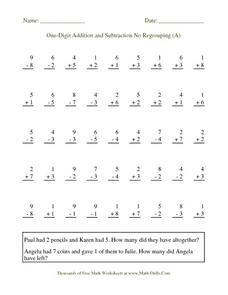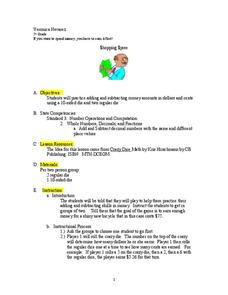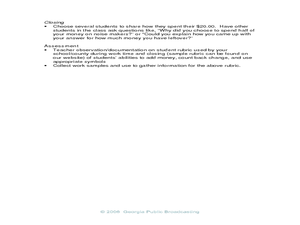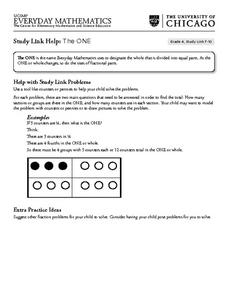Curated OER
Mixing Coins
Young scholars explore mixed (different denomination) coin sets and create different total amounts.
Curated OER
Math/Technology: Coin Combos
Second graders identify coin combinations needed to purchase items under a dollar. Using Kidspiration, they demonstrate three ways to purchase a pizza slice for 96 cents and choose an item which cost less than a dollar for other to...
Curated OER
Model and Solve Algebraic Equations
Examine multiple ways to solve algebraic equations. Pupils will generate a problem solving strategy that addresses the prompt given by the teacher. They will then share their problem solving strategy with the class. Graphic organizers,...
Perkins School for the Blind
Integrated Skills - Laundry
I hate doing laundry, even if it is an independent living skill that requires me to count money, follow a sequence, and sort clothing by color. Learners with multiple disabilities discuss what laundry is, why they need to do it, and how...
Curated OER
Quarters, Dimes, Nickels, and Pennies
In this money worksheet, 3rd graders will examine the photos of coins and write the correct amount. Students will complete ten problems counting quarters, dimes, nickels, and pennies to conclude how much is in each picture.
Curated OER
Value Your Digits
Third graders work with place value. In this place value lesson plan, 3rd graders write three digit numbers and tell the place value of each number. They compare numbers and money, regroup, discuss the value of coins, and count money.
Curated OER
Tzedakah: How Can We Help?
Young scholars define what constitutes a nutritious meal, the price of a healthy meal, and understand that some people can't afford healthy meals. In this healthy meals instructional activity, students estimate and research the cost of a...
Curated OER
Million Dollar Project
Each student is given the task of spending $1 million. The way students spend their money is dependent on a theme such as "creating a dream world," "taking a trip," or "doing something to better society." Each student researches,...
Virginia Department of Education
Probability
Classes explore different scenarios using manipulatives to learn about the difference between independent and dependent probability. Learners experiment with colored chips to model the two types of probabilities. To test their...
Virginia Department of Education
Greetings
Welcome learners to the world of algebra. Use a instructional activity that poses a situation involving the profit from creating greeting cards to teach about algebra. It requires scholars to use linear functions and inequalities to...
Curated OER
One-Digit Addition and Subtraction No Regrouping (A)
In this math worksheet, students solve 81 problems in which one-digit numbers are added and subtracted. Problems are in a vertical format with addition and subtraction mixed in each row.
Curated OER
Planning and Shopping for the Menu
Students plan a menu considering the number of people to be served and the amount of money they have to work with to buy the necessary ingredients.
EngageNY
More Examples of Functions
Discrete or not discrete? Individuals learn about the difference between discrete and non-discrete functions in the fourth installment of a 12-part module. They classify some examples of functions as being either discrete or non-discrete.
Curated OER
Shopping Spree
Sixth graders examine currency by completing monetary equations. In this economics lesson, 6th graders participate in a numbers experiment where they roll a die and earn money based on their roll. Students compete for their fictitious...
Curated OER
Flip a Coin
Students are introduced to the concept of probability. In groups, they make a prediction about how many times a coin might show heads or tails when flipped. They carry out the experiment and record their results to compare it to their...
Curated OER
Shopping for a Party
Second graders produce a budget for a party. In this money management lesson, 2nd graders create a budget for an imaginary party they will have based on a $20.00 limit. Students observe a video clip in class discussing budgets.
Curated OER
The One
For this problem solving worksheet, 4th graders utilize counters or pennies to learn about the parts of a whole in 4 groups of 3 circles that equal 12 counters.
Illustrative Mathematics
Price per Pound and Pounds per Dollar
Help learners understand the concept of unit rate as it is applied to buying beans at a grocery store. The objective is to determine the unit rate in two ways, and then apply each ratio to an additional problem. The attached commentary...
Curated OER
Tiling Tessellations
Young scholars explore tessellations. In this shapes and geometry lesson, students describe the attributes of many of the shapes displayed on an Elmo. Young scholars create examples of tessellations using pattern blocks.
Curated OER
Home Living / Daily Living: Shopping List 2
I've done this exercise with my special needs learners more times than I can count. They practice getting ready to shop at the grocery store by identifying items on their shopping list. They match grocery items to the proper department...
Curated OER
You're the Cashier!
Third graders use manipulatives and computers to count back change from amounts up to $5.00.
Curated OER
A Present for the Teacher
In this math word problems worksheet, learners read the story about Gina and the gift she wants to buy and make for her teacher. Students then determine if she has enough money to make the specific patterned necklace.
Curated OER
Math Lesson: Just How Many is a "Million Dead"?
Students are able to convert large numbers into meaningful ratios. They are able to conceptualize 1 million. Students grapple with the concept of a million. They use this activity to convey the idea of millions by converting war death...
Curated OER
Play For Pay
Young scholars practice various skills with manipulatives, such as counting correct money amounts to pay for manipulatives.

























